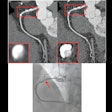CT angiography's robust ability to exclude coronary artery disease is hampered by its detection of false-positive high-grade lesions that are not hemodynamically relevant. But measuring the lesions may improve CT's predictive powers.
"Coronary CT angiography [CCTA] has established itself as gatekeeper to invasive coronary angiography," Dr. Fabian Plank, from Austria's Innsbruck Medical University, told AuntMinnie.com. "With excellent accuracy to exclude coronary artery disease, reliable predictive factors for hemodynamically relevant stenosis are still scarce. Defining a threshold for minimal lumen area may help identify relevant coronary stenosis."
Forty-five subjects with at least one high-grade stenosis in a proximal coronary vessel underwent CCTA followed by invasive angiography. The study team measured mean lumen area at CCTA to assess the relevance of high-grade lesions, comparing it with angiography results.
A minimal lumen area cutoff of 1.9 mm2 or less showed the greatest accuracy for predicting significantly increased hemodynamic relevance, the group found. The added value of these measurements can help identify relevant coronary stenosis, the authors will report in this session.



















